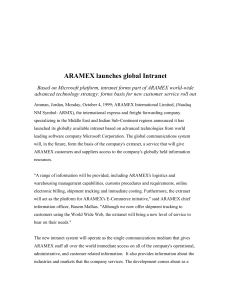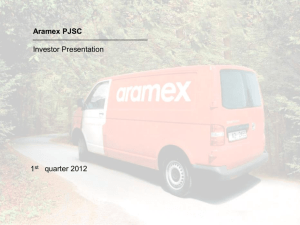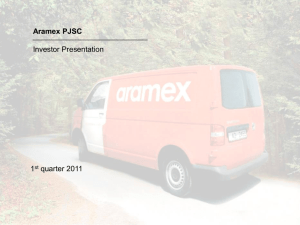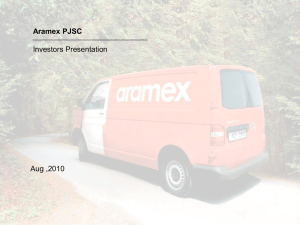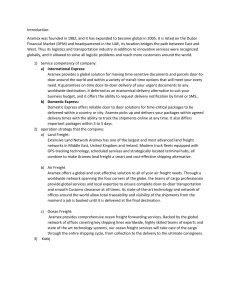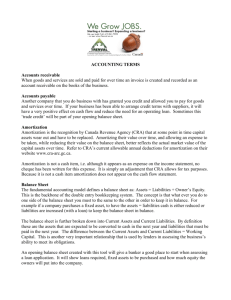& Meeting with January 22nd 2007
advertisement
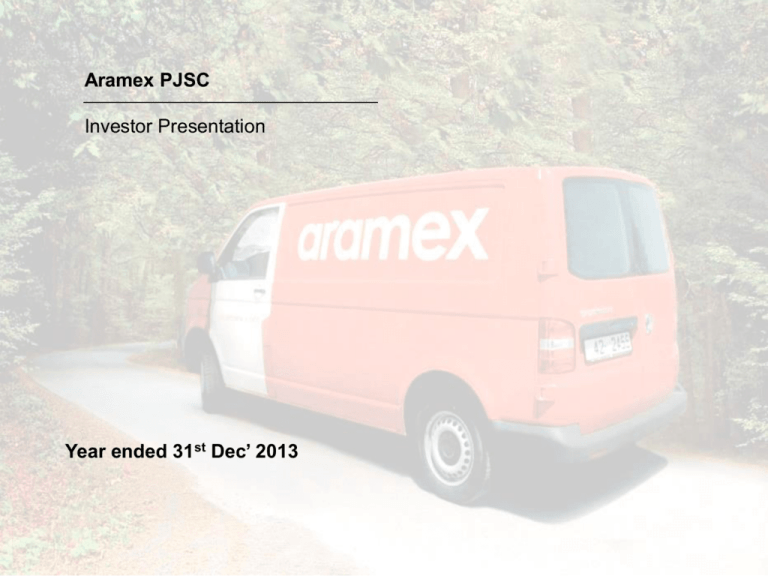
Aramex PJSC Investor Presentation Year ended 31st Dec’ 2013 Company Profile Company Structure Strategic Direction Financial Analysis Aramex Quick Overview Highlights Background Established: 1982, 27 years in operation Hubs: Main hubs in Amman, Dubai, Hong Kong, Liege, London, New York and Singapore. Offices: 309 offices in 200 major cities worldwide Staff: Over 10,295 employees Founder of the Global Distribution Alliance (GDA) and co-founder of the WFA World Freight Alliance. Activities: Aramex is a logistics and supply chain management company providing total transportation solutions – One Stop Shop. Financial Performance Year 2012 Revenue (Year'12): US$846 million Gross Margin (Year'12): 53.6% Net Income (Year'12): US$66.5 million Net Margin: (Year'12 ) 7.9% Shareholders Equity (Year '12): US$557 million Total Assets (Year'12): US$739 million Cash (Year'12): US$91 million Financial Performance Year’13 Revenue (Year'13): US$9055 million Gross Margin (Year'13): 54.4% Net Income (Year'13): US$75.7 million Net Margin: (Year'13 ) 8.4% Shareholders Equity (Year'13): US$579 million Total Assets (Year'13): US$813 million Cash (Year'13): US$164 million Aramex Background History Ownership 1982 1997 2002 2005 Established as a Privately Held Company First Arab-based Company on NASDAQ Returned to Private Ownership Public on Dubai Financial Market Product Progression 1982 Express Wholesale Delivery 1984 Express Retail 1985 Multiple Product Offering 1997 2004 Value Added Services Supply Chain Solutions Shareholders Value Creation Growth in Aramex’s Value (US$ Million) Value 1400 1200 1000 800 1,212 600 829 400 569 200 25 65 718 797 Dec-11 Dec-12 185 0 1997 - Listing 2002on Nasdaq De-listing from 2005Nasdaq Listing on DFMDec-09 Dec-10 Dec-13 Aramex Geographic Coverage Aramex People Growth in Number of Staff in the past 7 years 11,432 11,649 9,500 8675 7600 8100 6600 6,031 4,002 2005 2006 2007 2008 2009 2010 2011 2012 2013 Sustainability Key Sustainability Issues Aramex is one of the first companies in the region to report on its sustainable business practices • Community Empowerment: Community based projects that target community and youth’s needs through a highly interactive participatory approach. Partners include NGOs, private sector, public sector, community centers, etc. • Youth Empowerment & Education: Providing internship and training opportunities to students, as well as developing applied training programs in partnership with universities. • Sports: Sponsorship of sports events, the Riyadi Club (Basketball and Squash) in Jordan, Jeddah United (the first women basketball team in Saudi Arabia, etc.) • Environment: Introduction of Hybrid cars into aramex fleet, change to unleaded gas, using biodegradable and recycled material, commitment to become the first carbon neutral company in the region, etc. • Emergency Relief : Providing logistics support and aid donation campaigns to disaster stricken areas such as: Asia Tsunami, Pakistan Earthquake, Lebanon War, Gaza War, etc. Company Profile Company Structure Strategic Direction Financial Analysis Asset Light Model • Aramex asset-light business model translated into a high degree of flexibility and agility in pursuing opportunities as well as efficient cost management. • During the recession, Aramex asset-light business model allowed the company to create considerable efficiencies improving both the gross profit and net profit margins. (Gross Profit) & (Net Income) Margins 60% Margins 50% 40% 30% GP% 20% N.I% 10% 0% 2008 2009 2010 2011 Years 2012 2013 The Aramex Model Highlights Federal System Front Line Global Services Office • Federation of interdependent companies, that function as an independent unit managed by a local CEO • Each unit sets its own business plans, objectives and budgets in line with the corporate strategy • Manages interaction among members of the federation • Sets policies, procedures, & monitors compliance • Provides marketing, network infrastructure & IT infrastructure • Aramex geographic regions are divided into five areas: Levant, Gulf, Africa, Asia and West (Europe and US) Area Boards • Each area has a board composed of the senior regional manager, and other functional directors …etc • Area boards are responsible for the area’s strategic direction, budgeting, performance, and operations The Aramex Model Culture and Values Highlights Unique Corporate Culture Belief that people are Aramex’s most significant asset. Encouraging creativity, innovation and entrepreneurship. Empowering employees through continuous development & training. Promotion from within Committed to economic and social development as well as environmentally friendly practices. Customer centric and dedication to service excellence Key Values Decentralized and flat organization Trust based system that empowers the front line Company Profile Company Structure Strategic Direction Financial Analysis Vision: To enable and facilitate regional & global trade & commerce • Emerging markets: Capitalizing on experience, technology, product offering and international network by expanding the geographic reach into emerging economies with high growth potential. • Core markets: Leveraging and expanding infrastructure in existing geographic locations to strengthen market positioning by introducing new products and services. • Mediums of geographic expansion: • Franchising which will provide Aramex with a revenue stream, requiring minimal capital and management. • Small and medium-sized attractive acquisitions and Joint Ventures which can be integrated. Regions Identified for Geographic Expansion Aramex has extensive knowledge and experience in underdeveloped and developing markets and sees tremendous value in developing its global network by introducing its asset light model and product offering into new markets with high growth potential. Taking the Aramex model to new markets will strengthen its position as a key global provider specialized in emerging markets while operating a global independent network: Potential areas for expansion 1. Africa and CIS: Aramex is looking to invest in key African and CIS markets that enjoy political stability and economic growth potentials by working with partners that possess industry knowledge and can benefit from Aramex’s network and know-how. 2. Asia: Aramex will further expand its current operations in locations like Singapore, Hong Kong, Indonesia, Vietnam, while developing its gateways in China and looking for investment opportunities in other South East Asian countries. The Asian presence aims at servicing important trade routes between Asian markets and other markets. 3. India: Aramex has a sizable operation in India that offers international and domestic express service, and is looking to further enlarge its geographic presence and product offering. Expansion through Acquisitions Advantage Performance Financial Management / Employees Highlights Profitable company with margins in line with Aramex’s margins. Capacity to support reasonable levels of leverage to allow for financing. Proper financial disciplines with accredited auditors. Non-asset based companies. Experienced management teams that are willing to continue post acquisition Track history of having met projections and budgets Diversified client base with minimal reliance on top clients or on network of agents Not part of or affiliated with an already established network Strong corporate culture that is in line with Aramex’s Ability to change and incorporate the Aramex Accounting and IT systems. Leveraging Existing Infrastructure Highlights Expansion of Warehousing Facilities Acquisition New Product Development Supply chain solutions outsourcing is expanding in the Middle East and South Asia; warehousing is a critical pre-requisite for offering these services and where appropriate warehousing space is not available Aramex will invest in purpose built facilities There are a number of small to medium size businesses within the region that can be integrated with the existing Aramex operation and produce considerable efficiencies. Aramex continuously seeks to identify such companies to grow revenues and profit at higher efficiency. Aramex has succeeded in introducing new products when it acquired Info-Fort, a records and information management service provider. The offering has proved to be a very successful and niche one that has already expanded to 9 countries (GCC, Jordan, Egypt, Iran) and that has potential to other core markets. There are also various opportunities across the network, to further develop products and services, using existing infrastructure. Company Profile Company Structure Strategic Direction Financial Analysis Revenue Growth in Revenue (US$’000) CAGR 14.1% 905,309 836,353 699,971 602,297 533,896 2009 2010 2011 2012 2013 Product Distribution Change in Product Distribution Year'13 2009 Logistics, 6.3% Others, 7.6% Express, 32.0% Domestic, 15.4% Logistics 5.1% Domestic 19.4% Freight Forwarding, 38.7% Others 6.6% Express 31.8% Freight Forwarding 37.1% Geographic Distribution Change in Geographic Distribution 2009 Europe, 18.2% North America, 1.5% Year'13 North America 1.5% Asia, 6.1% Asia 8.0% Europe 15.8% Middle East & Africa, 74.2% Middle East & Africa 74.6% Gross Profit & Gross Margin Growth in Gross Profit (US$’000) CAGR 12.9 % 56.5% 53.8% 301,705 324,066 2009 2010 53.9% 52.6% 368,048 450,455 2011 Gross Profit 2012 GP% 54.2% 490,470 2013 Net Income & Net Margin Growth in Net Profit (US$’000) CAGR 10.8 % 9.4% 9.2% 8.2% 7.9% 8.4% 75,684 66,471 50,179 2009 55,572 57,599 2010 2011 Net Income 2012 Net Margin 2013 Aramex PJSC Balance Sheets All values in 000' USD Assets Current Assets Cash and cash equivalents Receivables (net) Other current assets 2008 A 2009A 2010A 2011A 2012A 2013A 93,619 94,285 26,686 136,650 95,044 23,688 151,048 110,012 26,602 85,501 136,054 46,029 90,855 158,870 36,858 178,885 164,434 34,561 Total current assets Non-Current Assets Property, Plant and equipment (net) Goodwill (net) Other non current assets Total non-current assets 214,591 255,382 287,662 267,584 286,583 377,880 65,449 219,311 3,102 287,862 67,232 232,377 5,435 305,044 90,438 235,037 9,435 334,910 121,266 275,039 14,862 411,167 155,170 272,056 25,496 452,721 147,464 265,106 22,549 435,119 Total assets 502,452 560,426 622,572 678,751 739,303 812,999 3,894 3,185 30,816 54,802 92,697 2,437 2,037 32,248 63,290 100,012 1,869 1,828 35,165 71,720 110,582 5,295 3,268 44,444 84,522 137,529 3,085 4,276 42,529 103,591 153,481 0 13,424 44,426 112,707 170,557 4,293 14,324 18,617 7,884 1,760 16,516 18,276 7,663 1,771 18,585 20,356 6,692 2,624 22,321 24,945 8,433 3,367 25,337 28,704 8,830 34,879 28,452 63,330 10,039 329,467 6,997 158 (1,668) 362,414 11,143 611 (697) 398,655 16,956 345 (1,724) 398,655 23,774 (137) (4,820) 398,655 33,188 398,655 39,551 48,300 61,005 (3,376) 74,086 (4,160) 94,532 (9,433) (806) (4,360) 131,044 (24,663) 3 (4,292) 159,819 Total shareholders' equity 383,254 434,475 484,942 507,844 548,288 569,073 Total Liabilities, minority interest and shareholders' equity 502,452 560,426 622,572 678,751 739,303 812,999 Liabilities, Minority Interest and Shareholders' Equity Current Liabilities: Due to Banks Current Portion of LTD Trade payables Other current liabilities Total current liabilities Non-Current Liabilities: Long term debt Other non current liabilities Total non-current liabilities Minority interest in subsidiaries Shareholders' Equity: Issued and paid-up capital Reserve Cumulative change in fair value Accumulated other comprehensive income (loss) Cash Flow Hedge Reserve arised from acquisition of non-controlling interest Retained earnings
